Browse using the new Vinous website now. Launch →
Printed by, and for the sole use of . All rights reserved © 2015 Vinous Media
Châteauneuf-du-Pape 2024: Dark Elegance
BY NICOLAS GREINACHER | OCTOBER 30, 2025
The powerful Southern Rhône sun may be a constant, but the wines of Châteauneuf-du-Pape prove that every year brings its own surprises. This report focuses on 2024, a demanding growing season in which downy mildew and coulure cut yields, frequently nudged blends toward Mourvèdre and Syrah and often delivered darker-colored reds with less Grenache opulence than usual. I’ll also offer a final word on 2023, an approachable, crowd-pleaser vintage marked by gentle structures and broad appeal.
A first glimpse at 2025 flags very early Roussanne harvesting and continued mildew pressure, sharpening questions about variety choice and adaptation in an increasingly erratic climate. Finally, I share a few thoughts on bulk wine, weighing its role as a financial and distribution safety net against the risks it poses to the region’s image and quality perception.
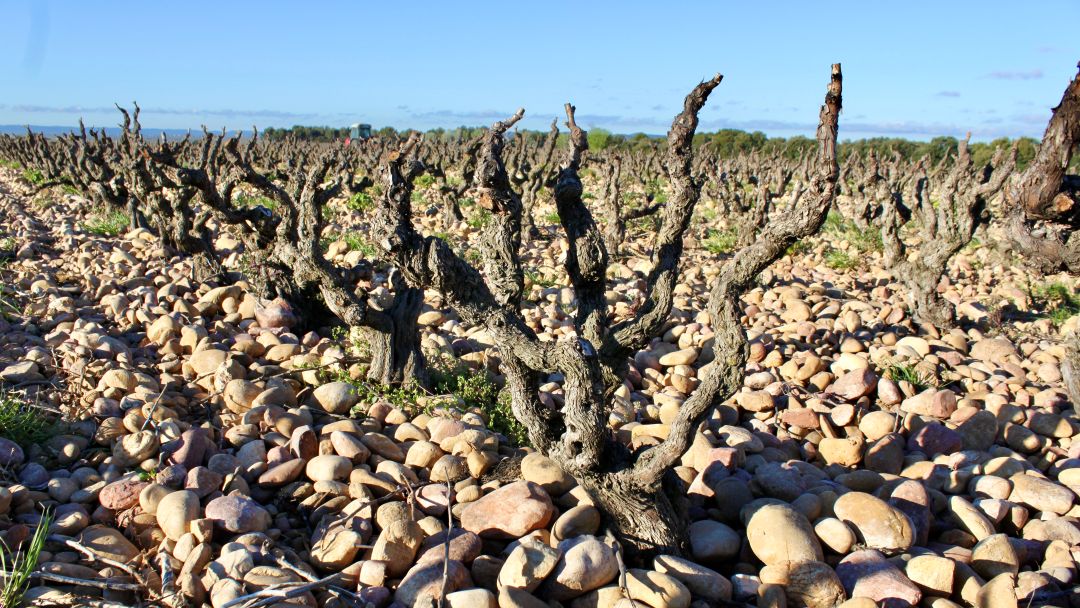
Across Châteauneuf-du-Pape, vines often grow on a sea of pebble stones.
The 2024 Vintage
Mild weather and abundant rainfall encouraged vigorous growth early in the year. Paul-Vincent Avril of Clos des Papes noted that rainfall between January and March was up 50% from the year before. Strong mistral winds helped protect against frost, but wet soils and windy conditions made vine treatments difficult—particularly against downy mildew, which started to emerge by the end of April. By mid-May, flowering began in selected plots, and the combination of temperatures above 25°C and regular precipitation increased fungal disease pressure. “In 2024, we started treatments in April and carried out a total of 20 applications through the year, the highest number I’ve ever seen,” recalled Christophe Sabon of Domaine de la Janasse.
Growers adapted what they learned from downy-mildew-plagued vintages such as 2018. Avril explained that at Clos des Papes, copper doses were increased at the start of the season to 400-500 grams per hectare (as opposed to 200-300 as in the past), which reduced the need for later treatments. “Our final spray was on July 1,” he said, “and by starting with higher doses earlier in the season, we were able to protect sensitive clusters at véraison.” Claire Michel of Le Vieux Donjon agreed, noting that mildew arrived earlier and more aggressively in 2024 compared to 2018, forcing the team to begin treatments by the end of April rather than waiting until May as in the past.
Like Domaine de la Janasse, Le Vieux Donjon faced the challenge of working organically. “Organic products are less effective against downy mildew than conventional products, so we have to spray more often and at a higher cost,” Michel explained. “There’s no margin for error—you can’t miss a treatment. We’re a small family estate, but luckily, my brother handles the spraying himself.” In 2024, mildew pressure remained confined to the period before July and did not harm grape quality. Had the fungal disease persisted throughout the summer and damaged leaves more, photosynthesis would have been compromised, risking uneven grape ripening.
But by June, another decisive factor came into play: coulure. This phenomenon, where flowers fail to develop into berries, reduces fruit set and can lower yields significantly. Coulure can occur when carbohydrate supply to the flowers is disrupted, often through poor photosynthesis in cold or overcast conditions, or when vines shut down in hot, dry weather. Vigorous shoot growth can also divert carbohydrates from clusters, a problem often seen on fertile soils. Grenache, the dominant variety in Châteauneuf-du-Pape, is especially prone to coulure, which in 2024 meant natural yield reduction and less need for potential green harvesting.
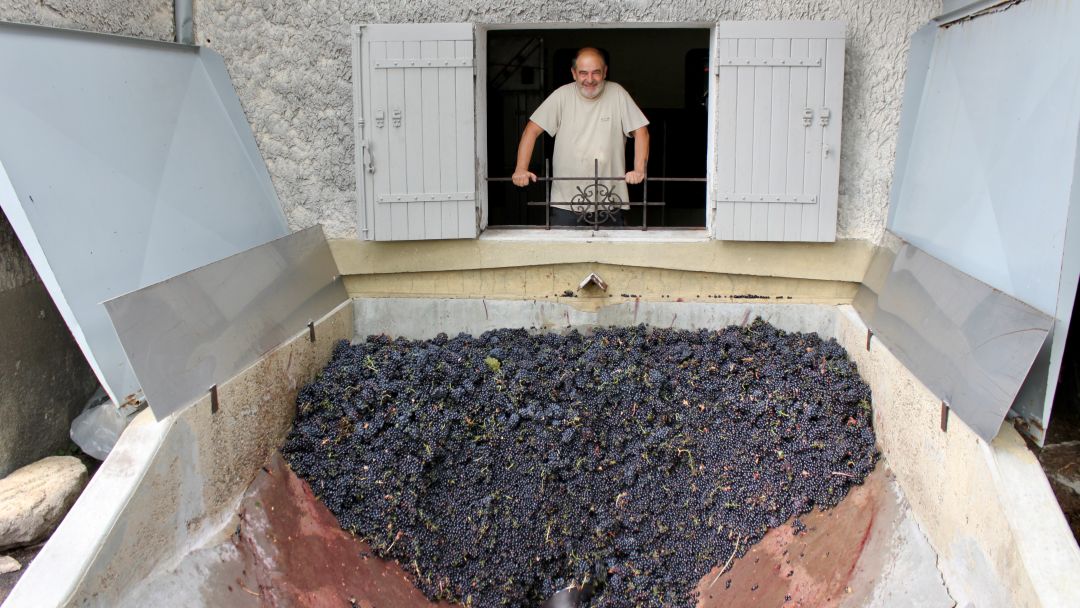
Christophe Sabon of Domaine de la Janasse, delighted by the arrival of the 2025 harvest.
Biodynamic producer Sophie Armenier of Domaine de Marcoux observed similarities to 2017 and 2010, other years with significant coulure. “When it’s cold at first, the vine grows slowly, then suddenly it turns warm and the growth explodes. During flowering, the vine can’t do both—grow and flower—so fertilization fails. In my experience, coulure years occur when the weather alternates between hot and cold,” Armenier explained. Laurence Féraud of Domaine de Pegau made a distinction between quantitative and qualitative coulure. The latter, she noted, can actually benefit quality: “Clusters are looser, berries less tightly packed, which prevents rot if rain comes later. Yields drop, but the grapes can be healthier.”
It is therefore important to note that lower Grenache yields due to coulure do not necessarily mean poor fruit quality. Indeed, benchmark vintages such as 2010 suffered significant coulure and yielded outstanding wines. In 2024, fantastic Mourvèdre and promising Syrah compensated for the shortfall in Grenache, allowing producers to maintain quality and balance in their multi-variety blends. In vintages like 2024, Châteauneuf-du-Pape grape growers are certainly glad that the appellation rulebook allows the flexible use of 13 permitted varieties (18 if the five color variants are also accounted for).
From August onward, dry weather brought relief and ended mildew outbreaks. By mid-August, véraison was complete almost everywhere. Warm days were tempered by cool nights, helping to preserve acidity and freshness, the latter being a key characteristic of many samples I tasted for this report. On September 9, daytime highs still touched 35°C, but nights stayed under 19°C. Harvest began around September 10 with white varieties. By early October, most red varieties were picked and fermentations were well underway.
With both downy mildew and coulure negatively impacting yields, final volumes were the lowest since 2018, coming in at just below 25 hectoliters per hectare (hl/ha) throughout the appellation. Domaine du Vieux Télégraphe reported 23 hl/ha, Famille Isabel Ferrando 20 hl/ha and Le Vieux Donjon just 19 hl/ha, one of the smallest in their estate’s history. This is a stark contrast to 2023, when most wineries came in at or just below the appellation limit of 35 hl/ha.
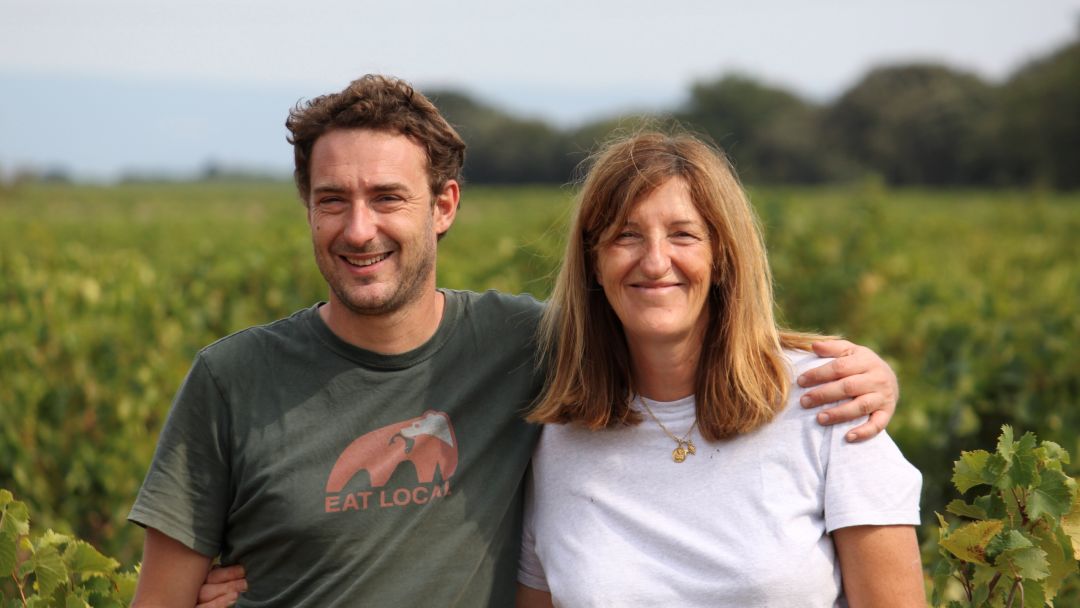
Together with her son Vincent, Sophie Armenier upholds Domaine de Marcoux’s reputation for consistent, ageworthy wines.
Looking at what’s in the bottle, lower Grenache yields shifted blends toward Mourvèdre and Syrah in 2024, leading to darker-colored wines with more spice-driven complexity and fleshier aromatic profiles. In general, most wines remain positively fresh yet aromatically somewhat restrained. Though less charming in their youth, the 2024s are built with the balance and concentration for aging.
Overall quality in 2024 turned out less consistent than in 2023 as the growing season came with far more challenges, so buyers should be selective. Of all the reds I have tasted so far, Clos des Papes, Clos Saint-Jean and Famille Isabel Ferrando deserve recognition for producing some of the most promising Châteauneufs of the 2024 vintage. As for white Châteauneuf-du-Pape, Château de Beaucastel and Famille Isabel Ferrando produced the appellation’s finest.
A Final Word on 2023
The 2023 vintage in Châteauneuf-du-Pape will be remembered for crowd-pleasing wines without any rough edges, marked by notable balance and approachability. It was a warm, harmonious year that yielded wines with plenty of ripe dark fruit, spiciness, ample richness and subtle structure, without the weight or austerity that would require long cellaring. A key ingredient in 2023 was generous yields, which helped prevent overly concentrated wines. There is nothing challenging about these wines, which makes them especially enjoyable both in youth and over the medium term.
Kudos to Château de Beaucastel and Domaine de la Vieille Julienne for crafting the finest red wines of the 2023 vintage. Ultimately, 2023 is not a vintage that rewrites the story of Châteauneuf-du-Pape, but one that reinforces it. Rich yet balanced, ripe yet refreshing, fruit-driven yet spicy—the wines embody the traits that draw people to the appellation in the first place. Although it may never go down as one of the most intellectual vintages, 2023 deserves recognition as a reliable and widely appealing year that will win the hearts of Rhône aficionados.
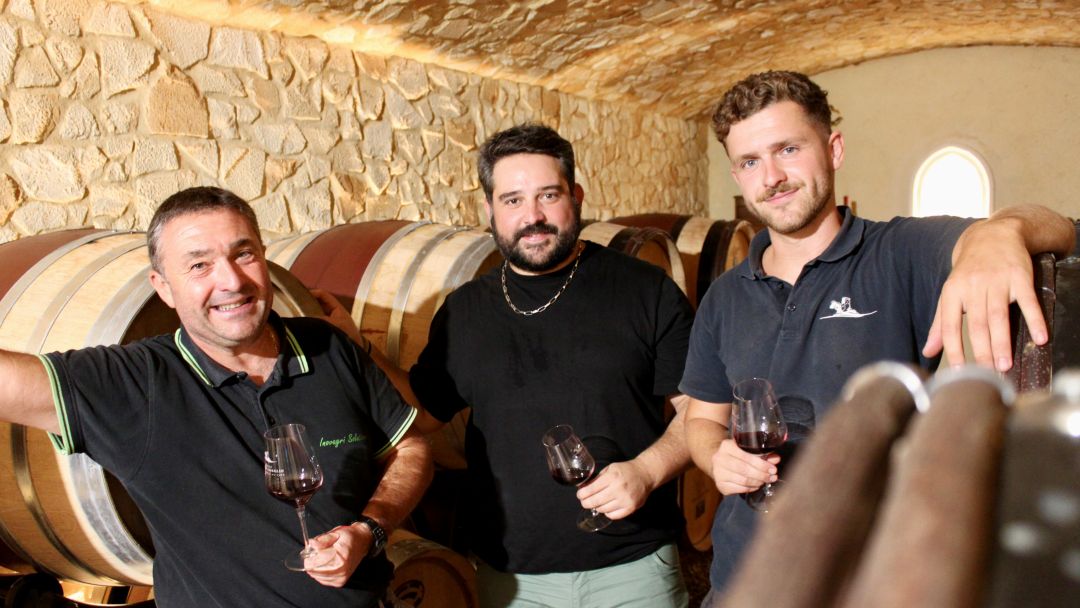
Thierry Usseglio at left, joined by his nephews Gregory and Maxime at Domaine Pierre Usseglio, celebrates the return of the rare Cuvée Not for You! in 2023 after a four-year absence.
A First Glimpse at 2025
While tasting the 2024s at the end of August this year, I noted that some Châteauneuf-du-Pape estates had already brought in their Roussanne grapes. Isabel Ferrando and her team harvested on August 14, the earliest in the estate’s history. The decision was driven by an approaching heatwave, but it also reflects a deeper concern. Many growers now fear that Châteauneuf-du-Pape is becoming too warm and dry for Roussanne, and some are already considering regrafting to more resilient white varieties like Clairette or Grenache Blanc.
With fewer cases of coulure in 2025, downy mildew pressure remained similar to that of 2024. Sophie Armenier of Domaine de Marcoux explained, “In both 2024 and 2025, we faced very rainy springs, unlike in the more distant past. When I began working 30 years ago, mildew pressure in April and May was minimal. Now it’s a struggle almost every year. Constant rain, humidity and warmth push the vines to grow very early. It has become far more complicated than before. In the past, we never carried out more than ten treatments per season, but that has become the norm.”
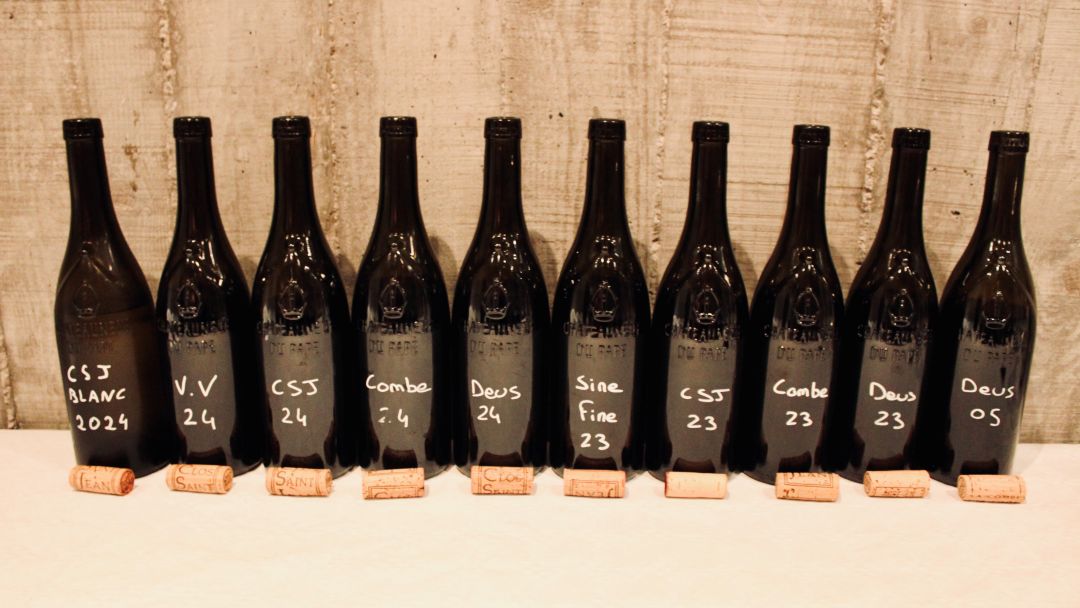
Clos Saint-Jean’s collection expands in 2023 with the introduction of the Sine Fine (the sixth bottle from left).
To Bulk or Not to Bulk
Bulk wine remains prevalent in Châteauneuf-du-Pape, representing a little more than half of the region’s total production. Although seemingly high, this is by no means unusual in the Southern Rhône, with Gigondas and Vacqueyras currently at over 50% as well.
For many wineries, bulk wine production serves a practical purpose, offering both financial stability in high-yielding vintages and a useful outlet for fruit from young vines or lots considered less suitable for estate bottlings. Bulk wine also spares smaller estates the burden of managing large-scale sales and distribution, allowing them to focus on vineyard work.
Handled well, bulk wine can benefit the appellation as a whole. Quality lots sold to respected négociants reach international markets, widening Châteauneuf’s presence and giving consumers access to affordable price points. For many drinkers, these wines are an introduction that may lead them to seek out estate-bottled cuvées, helping to grow the region’s reach. And quite often, the rise in bulk wines can be attributed to growing interest from major négociant houses, who in turn see an appetite for these wines from end consumers.
The risks emerge when volumes climb too high. With around 100,000 hectoliters produced annually, the fact that half of that volume enters the négociant trade may raise concerns about quality dilution, especially when bulk wine is used as a channel for weaker lots. Some Châteauneuf winemakers suggest limiting bulk to as low as 20% to protect the image of the appellation. In the end, bulk wine is both a safety net and a potential liability—valuable when kept in check, but a risk if it overshadows the identity and standards that make Châteauneuf-du-Pape one of France’s most distinctive winegrowing regions.
Given the current conditions in major global wine markets where oversupply is far more common than scarcity—particularly for full-bodied, high-alcohol red wines—Châteauneuf-du-Pape as an appellation may want to reflect upon whether maintaining such a high proportion of bulk wine production is a sustainable strategy going forward.
I tasted the majority of the wines in this report in Châteauneuf-du-Pape in late August 2025, with follow-up tastings at my office in Zurich.
© 2025, Vinous. No portion of this article may be copied, shared or redistributed without prior consent from Vinous. Doing so is not only a violation of our copyright but also threatens the survival of independent wine criticism.
You Might Also Enjoy
Northern Rhône 2023: The Art of Perseverance, Nicolas Greinacher, January 2025
Châteauneuf-du-Pape: Alluring 2023s and Benchmark 2010s, Nicolas Greinacher, November 2024
Châteauneuf-du-Pape 2022: Bring It On, Nicolas Greinacher, June 2024
Northern Rhône: Where Diversity Ignites the Senses, Nicolas Greinacher, March 2024
Châteauneuf-du-Pape New Releases: Welcome to the Pleasuredome, Nicolas Greinacher, June 2023
Show all the wines (sorted by score)
- Aimé Arnoux
- André Brunel
- Arnoux & Fils
- Baron de Montfaucon
- Bosquet des Papes
- Cellier des Princes
- Château Beauchène
- Château Cabrières
- Château de Beaucastel
- Château de Fonsalette
- Château de la Font du Loup
- Château de Nalys
- Château des Fines Roches
- Château de Vaudieu
- Château Fortia
- Château Jas de Bressy
- Château La Nerthe
- Château Maucoil
- Château Mont-Redon
- Château Mont-Thabor
- Château Pegau
- Château Rayas
- Château Sixtine
- Clos de l'Oratoire des Papes
- Clos des Papes
- Clos du Calvaire
- Clos du Mont-Olivet
- Clos Saint-Jean
- Clos St Antonin
- Domaine Albin Jacumin
- Domaine André Brunel - Les Cailloux
- Domaine André Mathieu
- Domaine Berthet-Capeau
- Domaine Berthet-Rayne
- Domaine Chante Cigale
- Domaine Charvin
- Domaine Christophe Mestre
- Domaine Clef de Saint-Thomas
- Domaine de Beaurenard
- Domaine de Cristia
- Domaine de Ferrand
- Domaine de la Charbonnière
- Domaine de la Côte de l'Ange
- Domaine de la Janasse
- Domaine de la Mordorée
- Domaine de la Vieille Julienne
- Domaine de l'Harmas
- Domaine de Marcoux
- Domaine de Panisse
- Domaine de Saint Paul
- Domaine du Bois de Saint-Jean
- Domaine du Grand Tinel
- Domaine du Pegau
- Domaine du Père Caboche
- Domaine Duseigneur
- Domaine du Vieux Télégraphe
- Domaine Élodie Jaume
- Domaine Fréderic Stehelin
- Domaine Galevan
- Domaine Henri Bonneau
- Domaine Juliette Avril
- Domaine La Barroche
- Domaine L'Abbé Dîne
- Domaine La Boutinière
- Domaine La Cabotte
- Domaine Le Mourre
- Domaine le Prieuré des Papes
- Domaine L'Or de Line
- Domaine Lou Régalet
- Domaine Mas Saint-Louis
- Domaine Moulin-Tacussel
- Domaine Paul Autard
- Domaine Pierre Usseglio
- Domaine Raymond Usseglio & Fils
- Domaine Roger Perrin
- Domaine Saint-Laurent
- Domaine Saint-Préfert
- Domaine Saint Siffrein
- Domaine Santa Duc
- E. Guigal
- Famille Brunier
- Famille Isabel Ferrando
- Famille Ravoire
- La Bastide Saint-Dominique
- Le Clos du Caillou
- Les Vins de la Palud
- Le Vieux Donjon
- Maison Chapoutier
- Mas de Boislauzon
- Ogier
- Réserve Saint Dominique
- Rhônea
- Saint Theodoric
- Stéphane Ogier
